This guide contains detailed advice on loading and towing practices to keep you within the law and protect you, your goods and others on the road.
This guide is for cars, vans, station wagons, utes, 4-wheel drives and light trailers (vehicles whose maximum laden weight is less than 3.5 tonnes) or load weights less than 500kg.
For trucks, heavy trailers or loads of more than 500kg, refer to:
The official New Zealand truck loading code [PDF, 4.1 MB]
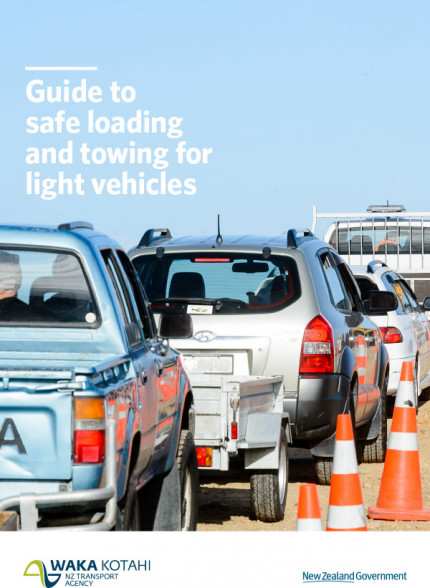
About two people a year are killed and five are seriously injured in crashes where the trailer was recorded as being the main contributing factor.
This guide contains detailed advice on loading and towing practices to keep you within the law and protect you, your goods and others on the road.
Most vehicles have tow ratings given to them by the manufacturer specifying the gross trailer weight braked, unbraked, or both, that the vehicle can safely tow. Although the law does not require these tow ratings to be followed, the NZ Transport Agency recommends that they be taken into account.
In addition to the requirements above, the law requires that every light vehicle and trailer combination must be capable of stopping within a distance of seven metres from a speed of 30km/h. In effect, this means that the maximum allowable weight of an unbraked trailer is limited by the weight and braking ability of the vehicle being used to tow it.
The Transport Agency recommends, as a guide, that the laden weight of an unbraked trailer should not exceed three quarters of the unladen weight of the towing vehicle and then only if the towing vehicle's brakes and tyres are in excellent condition. A trailer heavier than this may prevent the vehicle combination from meeting the seven metre from 30km/h brake performance requirement. To illustrate the increase in stopping distance when towing an unbraked trailer, consider a trailer with a laden weight equal to the weight of the towing vehicle.
This combination can be expected to have double the stopping distance of the towing vehicle alone, and even a towing vehicle with good brakes is likely to fail the legal brake performance requirement of seven metres from 30km/h. If the trailer is equipped with brakes, it may be possible to safely tow a trailer heavier than three quarters of the unladen weight of the towing vehicle, but the seven metres from 30km/h brake performance requirement still applies.
Note: Remember that a car, utility vehicle or light van is not permitted to tow more than one trailer or vehicle.

A trailer that is more than two metres wide, or extends more than one metre from the centre of the vehicle on either side must have one pair of front position lamps.
Any other trailer may have one or two front position lamps, but if only one is fitted it must be fitted on the side of the vehicle closest to the middle of the road.
A trailer must have at least one red rear-facing position lamp.
If the trailer was first registered after 1 January 1978 and is more than 1.5 metres wide, it must have two rear-facing position lamps fitted.
A trailer may have a maximum of two pairs of rear-facing position lamps.
A trailer first registered in New Zealand on or after 1 April 2012 must be fitted with one or two pairs of stop lamps.
A trailer first registered in New Zealand before 1 April 2012 must be fitted with one or two pairs of stop lamps if its construction, equipment or loading prevents following drivers from seeing an arm signal given by the driver of the towing vehicle.
The trailer must have at least two rear red reflectors fitted, one on each side.
The letters and numbers on the trailer registration plate must be lit by a white light. It is important that the white light doesn't dazzle following drivers or confuse them about which way the trailer is facing.
A trailer first registered in New Zealand on or after 1 April 2012 must be fitted with one or two pairs of rear direction indicator lamps.
A trailer first registered in New Zealand before 1 April 2012 must be fitted with one or two pairs of rear direction indicator lamps if its construction, equipment or loading prevents following drivers from seeing an arm signal given by the driver of the towing vehicle.
A trailer may be fitted with one or two pairs of front direction indicators.
Note: If your load covers up essential lights on your vehicle or trailer, you must fit temporary lights to your load to make sure you comply with the legal requirements set out above. For example, bicycles carried on a towbar-mounted cycle rack on the back of your vehicle can often cover up your tail lights.
A vehicle lighting retailer or garage can advise you on purchasing and fitting temporary lights to your load.
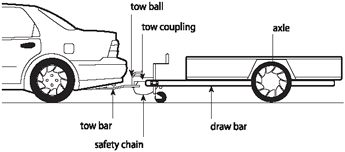
Although tow bars are not required to be rated and certifi ed on light vehicles, there are safety requirements. Your tow coupling and tow bar must be strong enough to safely tow your fully laden trailer. The tow bar must also be correctly fitted so that it transfers the towing forces to the structure of the towing vehicle without any distortions of the tow bar or the towing vehicle's bodywork/structure.
In addition, when you are loading the trailer, make sure that there will be a downwards force on the vehicle towbar at the point of attachment equal to about 10% of the weight of the trailer plus load. Do not put too much weight at the back of the trailer. Ensure there is a downwards force at the point of attachment, to improve the handling characteristics when you are towing.
The coupling on the trailer must have a manufacturer's rating appropriate for the gross laden weight of the trailer and be compatible with the tow ball size.
There are two sizes of tow balls in use:
The tow ball and coupling must be in good condition and securely attached to the tow bar and trailer draw bar respectively. When connecting the trailer to the towing vehicle, you must make sure that the tow coupling, electrical connection and safety chain/s are all connected correctly so that they work properly. Remember that the gap between the vehicle and the trailer must be no more than four metres.
There are three types of brakes:
1. Service brakes
2. Breakaway brakes
3. Parking brakes
Light trailers may be required to have service brakes, parking brakes, breakaway brakes or safety chains depending on the gross laden weight of the trailer. The table below outlines the requirements for the types of brake that must be fi tted to light trailers.
Requirements for service brakes, parking brakes, breakaway brakes and safety chains on light trailers:
| Type of brake | Gross laden weight of the trailer | ||
| 2000kg or less | 2001–2500kg | 2501-3500kg | |
| Service brake | Not required but, if fitted, must act on each wheel of at least one axle. |
Required: May be either direct or indirect. |
May be either direct or indirect, and must act on each wheel of at least one axle (the indirect service brake must comply with UN/ECE Regulation No.13). Note: A compliant brake system requires a brake on each wheel of the trailer. |
| Parking brake | Not required. | Not required. | Required, and must act on at least one complete axle. |
| Breakaway brake | Required unless fitted with an appropriate coupling and safety chain (the safety chain must be of sufficient strength to hold the trailer secure under all conditions of road use). | Required, unless fitted with an appropriate coupling and two safety chains. |
Required, unless fitted with an appropriate coupling and two safety chains. Note: If a breakaway brake is fitted, safety chains are still recommended but not required. |
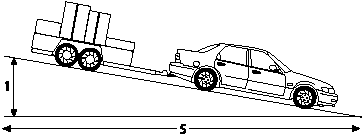
Regular maintenance of your trailer is very important:
A poorly maintained trailer can be a hazard to yourself and other road users. No matter how good you are at towing, you can never tow a badly maintained trailer well and safely.
Each vehicle has a maximum safe laden (or loaded) weight. Overloading the vehicle beyond this weight can compromise the vehicle's body, brakes, chassis, wheels and/or engine.
The laden weight and unladen (also called unloaded, tare or kerb) weight will be in your vehicle manufacturer's handbook or manual. Also look for any specific instructions on how to load the vehicle safely.
The maximum safe laden weight minus the unladen weight gives you the maximum load (including objects, people and animals) that the vehicle can carry.
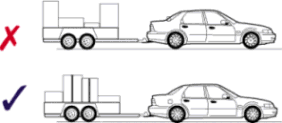
If part of the load is removed during the journey, you may need to rearrange and re-secure the rest of the load.
All loads including those carried on trailers should be properly restrained so they can't shift around while the vehicle is moving.
All objects should be restrained by being:
When you secure a load, bear in mind that it will try to move:
If you're using lashings to secure a load, you'll need to work out the strength of the lashings - known as ‘lashing capacity’.
Look on the lashing or its packaging for a figure (in kilograms) beside ‘lashing capacity’. If you see ‘breaking strength’ – then the lashing capacity will be half of this figure.
Fasten your load to the vehicle using as many lashings as required to achieve a combined lashing capacity equal to at least twice the weight of the load.
Note: A minimum of two lashings should be used to prevent the load, or part of the load, from twisting, rotating, pivoting or slewing
Secure lashings to suitable anchorage points (rails, hooks or eyes) on the vehicle.
If your vehicle doesn't have suitable anchorage points, investigate whether these can be fitted to your vehicle or use a vehicle that does have suitable anchorage points.
Tighten the lashings before beginning your journey. Check them during the journey and tighten the lashings again if necessary.
If possible, put the load against a headboard, sidewall or other rigid part of the vehicle structure to help hold it in place.
Note:
All loads that may be affected by air flow or by the motion of the vehicle should be covered.
Bulk (unbagged) loads such as silt, sand, gravel, builder's mix, leaves, grass clippings, prunings from vegetation, wood chips, sawdust, coal, firewood, dung, topsoil, fruit, vegetables, loose paper and general rubbish should be covered by a tarpaulin to prevent the load spilling or shedding.
Netting or metal mesh cages can adequately retain some loads, if the holes in the netting or mesh are smaller than the smallest load fragments.
Fragile loads (such as glass sheets) should be completely enclosed so that any pieces or shards will be retained on the vehicle if they break during the journey.
Objects inside a vehicle should be restrained against movement.
Seat backs (especially folding seats) may not be strong enough to restrain a load placed behind them. Check the vehicle's manual to see if the seat backs can restrain the load that you want to carry. If they can't, take steps to secure the load. This could be by lashings attached to appropriate anchorage points fitted within the vehicle. Other options include a load retaining wall or beam, or a full or partial cargo barrier constructed to Australia/New Zealand Standard AS/NZS 4034.1 or 4034.2: (2001).
Don't rely on the ‘grip’ (friction) between an object and the floor of the vehicle to restrain the load. Many objects are smooth and can slide easily across most surfaces. Also remember that this grip (friction) is lost when the vehicle goes over a bump that lifts the load upwards. Ensure there is a downward force at the point of attachment, to improve the handling characteristics when you are towing.
If your vehicle tows a trailer, you need to allow for this in calculating how much load your motor vehicle can safely carry. Remember that the brakes of your vehicle will also need to restrain the forward motion of the trailer (unless the trailer itself has effective brakes).
Look in your vehicle manual for the maximum weight your vehicle can tow.
Before you buy a roof rack, check your vehicle's manual to find out how much weight your vehicle can safely carry above its roof. Check the load that the roof rack itself can carry. Then look for a rack that suits your vehicle's roof shape and can be attached to appropriate places on your vehicle.
Evenly distribute objects along and across the rack (between the left and right sides, and between the front and back of the vehicle).
Be careful carrying long or bulky objects on a roof rack. Both the lashings holding the objects onto the rack and the fittings that hold the rack to the vehicle should be strong enough to keep both the rack and the objects secure in strong cross winds. If you're unsure about this, use additional lashings and attach these directly to the vehicle.
Remember that ...
If the load (including equipment used to support or retain the load) extends more than 200mm beyond the sides of the vehicle or trailer, or more than one metre beyond the front or back of the vehicle, then you must attach suitable warning device(s) to it.
During daylight you must attach:
or
During the hours of darkness, you must have lights on the load:
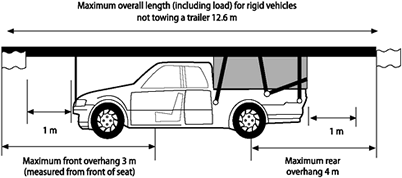
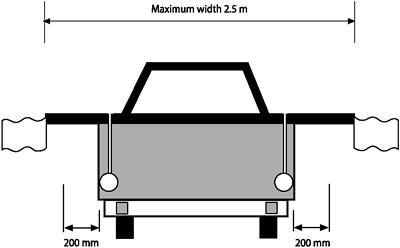

During the hours of darkness, the lights must be clearly visible in clear weather at a distance of at least 200 metres.
If the overall width of the projecting load is one metre or less, then place one flag or panel or light at the centre of the load. If the load is wider than one metre, then place a flag or panel or light at each corner of the projecting load.
Note: If your load covers up essential lights on your vehicle or trailer, you must fit temporary lights to your load to make sure you comply with legal requirements. A vehicle lighting retailer or garage can advise you on purchasing and fitting temporary lights to your load.
Vehicles are allowed to carry loads up to the maximum permitted size (dimensions) for that type of vehicle (provided the vehicle can be safely loaded that way).
Large loads (such as boats and gliders) that cannot be reduced in size to fit within the maximum vehicle dimensions (because they are indivisible) are allowed to be moved on roads as oversize (overdimension) loads. See factsheet 53 Overdimension vehicles and loads for the details of the conditions that need to be met before these loads can be moved.
These include cement, grain, gravel, wood chips, potting mix, fertiliser, soil, lime, coal, coke, carbonettes, bricks etc. They are often in large bags but are also sold in bulk. Close the bags at the top to prevent spillage. Make sure the bags won't move during the journey.
If the material is carried loose on a flat-deck vehicle with sides:
These include suitcases, cartons, boxes, trunks, shrink-wrapped packets of manufactured objects etc. Pack these against the sides of the vehicle and restrain them with suitable straps, ropes or webbing.
This can be packed in large metal, plastic or wooden containers, in large bags or in bulk. Securely close any containers or bags and restrain them so they don't move on the vehicle.
Bulk loads should be carried inside closed vehicles or covered by netting or tarpaulin (to prevent loose pieces flying off when the vehicle is moving).
Make sure that the caps, stoppers, corks, lids or valves of cans, cylinders and bottles are closed tightly before being placed in the vehicle.
Smaller cans and bottles can be packed in cartons or crates. Larger cylinders need to be secured in racks or cradles, held by lashings or packed in compartments.
Logs and posts are heavy items that need to be secured against movement in all directions.
Shorter logs, posts and fi rewood can be contained within vehicles with solid sides or load restraining cages, or restrained by lashings if they are tied into a bundle.
Chains should restrain larger logs and stumps, as set out in the Truck loading code.
Glass sheets should either be carried flat on the deck of the vehicle or in specially designed frames. If the frames are not enclosed inside the body of the vehicle, then the glass sheets should be fully enclosed by covers attached to the frames so that broken shards of glass will not fall on the road if the glass sheet shatters during the journey. Frames which are mounted outside the body of the vehicle should have flags or hazard panels (day) and lights (night) attached to them if they extend more than 200mm sideways beyond the body of the vehicle.
Sheets of plywood, plasterboard etc can be carried flat on the deck of the vehicle. If they are carried on roof racks, secure them with lashings against movement forwards, backwards, sideways and upwards. The front edge of these sheets needs to be particularly well secured to resist buff eting by air movement during the journey.
Pipes, ducts and hoses need to be secured against movement in all directions.
The appropriate way of securing them depends on the material the pipe is made of, its length and diameter and whether it is rigid or flexible.
Care needs to be taken when transporting machinery and metal objects because they may be heavy, be irregular shapes and have sharp edges. These need to be restrained during a journey. Special racks with clamps may be fitted to some vehicles to hold bicycles and other machinery.
Otherwise, packing and chains should be used to hold heavy metal objects in place on the vehicle or trailer.
Note: Bicycles carried in towbar-mounted cycle racks can often cover up the number plate or essential lights on the back of the vehicle. In these circumstances the driver is legally obliged to fit additional lights and/or number plates on the back of the load.
This should be carried on vehicles that are suited to its length. Pre-packed timber of one size is relatively easy to handle and secure with appropriate lashings. More care should be taken with different sized pieces. These need to be arranged and secured so the stability of the vehicle is maintained and the pieces do not become loose during the journey.
Ideally, boats and gliders should be carried on vehicles or trailers that have been specially designed to contain their size and shape. If any part of the boat or glider is not contained, it needs to be appropriately restrained to prevent movement.
See also the section, Loads overhanging the vehicle or trailer if the boat or glider extends more than 200mm over the sides of the vehicle, or more than one metre beyond the front or back.
Surf boards, windsurfer boards, paddles, kayaks, canoes and skis should be carried in or on racks that are suitable for the weight and size of the object. At least two clamps or lashings need to be used to keep them secure during travel if they're carried outside the vehicle.
Large boards that are placed on a roof rack can be severely affected by the air flowing over the vehicle. Both the lashings (or clamps) holding the board to the rack, and the fittings holding the rack to the vehicle, need to be strong enough to hold the board in place throughout the journey. Use additional lashings connecting the load directly to the vehicle if you are carrying a large board or canoe.
Animals should be transported in adequately ventilated cages, boxes, pens, crates, or containers that are suited to their size, and are held securely inside or attached to the deck of the vehicle.
Dogs (and other large animals) should only be carried on an open deck if they are securely tethered to the centre of the front of the deck. This allows the cab of the vehicle to protect them from the wind. The chain or lead tethering the animal should be attached to the collar or harness by a swivel so the animal can have limited movement.
The chain or lead should be short enough to prevent the animal's legs from reaching over the sides of the vehicle, but long enough to allow the animal to stand, lie down and move about slightly. Animals should be protected from extreme weather conditions.
If large animals are carried in the passenger compartment, a proprietary harness fitted to the seatbelts should restrain them. Otherwise they should be tethered in a ventilated space at the rear of the vehicle or placed behind a suitable restraining barrier.
Don't let animals travel with their heads protruding from the open window of a vehicle. They could be injured (particularly their eyes and neck).
Birds should be transported in suitably sized cages secured to the vehicle.
Fish should be transported in watertight containers secured to the vehicle.
Horse trailers: when towing a horse trailer you need to take extra care - as the horse moves, the trailer will sway.
Take care when carrying dangerous goods such as compressed gases and liquids.
These are often packaged in special containers with special valves or stoppers. Ensure valves are properly closed and stoppers and lids are secure before loading gases and liquids in or on the vehicle.
There are legal limits on how much of each dangerous goods substance you can carry and on the combinations of dangerous goods you can carry together. See the NZ Transport Agency's factsheets 67, 68 and 69 for more details of these restrictions.
The maximum open road speed for light vehicles towing trailers or towing other motor vehicles is 90km/h, provided that you have a rigid connection between the towed and towing vehicles, such as a towbar, drawbeam or drawbar. If you want to tow using a rope or other non-rigid connection, then the maximum speed on the open road is 50km/h.
Note: These are maximum speeds - drive slower if the conditions require it.
If you're carrying passengers you must ensure that they ride in a position where they are not likely to be injured during the journey. It is against the law for passengers to ride in a caravan being towed.

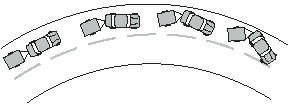
As you turn, the extra weight of the trailer (or towed vehicle) is likely to continue pushing your vehicle ahead, especially on gravel or greasy roads. Use brakes with caution while cornering; you could lose control and your trailer could jack-knife.

Allow extra space for stopping. Allow a four-second gap between you and the vehicle ahead – even more if it’s wet or windy.
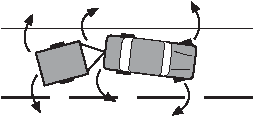
An unbalanced load can cause the trailer to pivot on the tow bar, forcing the towing vehicle to sway from side to side.
To help reduce the chances of swaying:
If the trailer starts to sway:

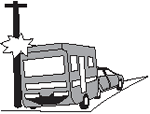

Remember to:
If you tow a motor vehicle during the hours of darkness, the towed vehicle must display a white light towards the front which shows the towing connection and red light towards the rear of the towed vehicle.
Available from the NZ Transport Agency:
Publications and legislation on the welfare and transport of animals are available at https://www.mpi.govt.nz/animals/animal-welfare/(external link)
Addtional resource:
Know how to tow – essential tips for towing a trailer [PDF, 501 KB]
Available from bookshops:
Note:
View other NZ Transport Agency rules and factsheets.
Page updated: 16 December 2022